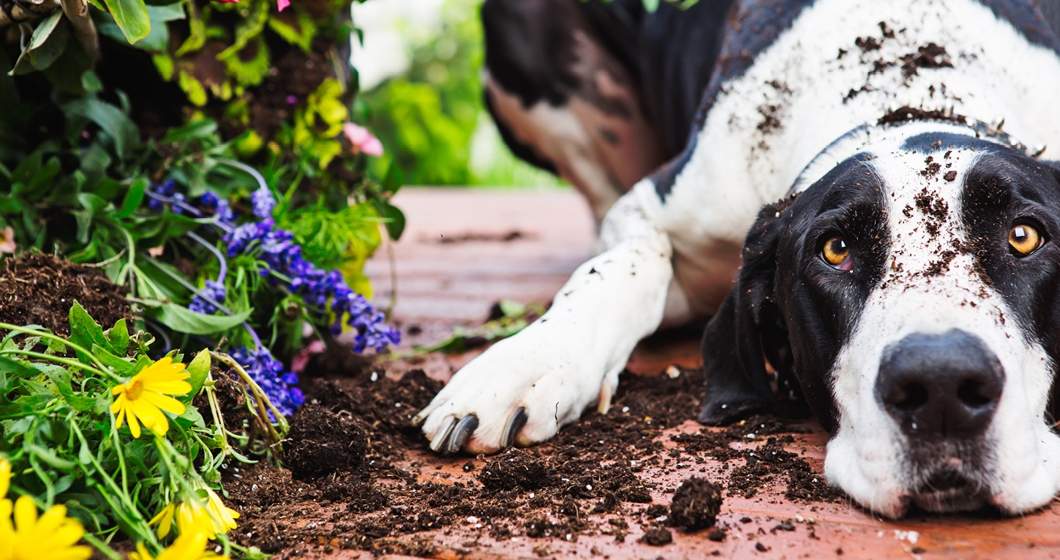Whether you’re a plant connoisseur or just starting to build your garden, be aware that some plants aren’t your dog’s friend. Many shrubs, trees, and plants commonly found in your garden and home can be dangerous if your dog consumes them.
Consuming toxic plants can cause mild to fatal symptoms in dogs. But you can be your pet’s protector! Here are the plants to know and the emergency planning you can do.
Common Symptoms of Plant Poisoning in Dogs
Sometimes, once your pet is exhibiting symptoms of poisoning, it may be too late to save your furry friend. Don’t wait. If you suspect that your dog has ingested a poisonous plant, call your vet as soon as possible.
Dog plant poisoning symptoms to watch for include:
- Vomiting and diarrhea
- Lethargy or a sudden change in energy
- Irritation around the mouth or lips
- Indigestion or loss of appetite
FAQs: Outdoor Plants & Houseplants That Are Poisonous to Dogs
Are poinsettias poisonous to dogs?
Yes, poinsettias’ toxic milky-white sap is toxic to dogs. Though this sap is only considered mildly poisonous and won’t kill your pet, it’s best to keep the plant out of your pup’s reach. Contact with the sap can cause:
- Skin irritation
- Nausea and vomiting
- Excessive drooling
- Sometimes diarrhea
Are hostas poisonous to dogs?
Yes, toxins called saponins make hostas bad for dogs. Ingesting a small amount is unlikely to harm your pet severely, but call your veterinarian in any case. Many homes have hostas because they are relatively low-maintenance and grow fast, but keeping them away from your pet is best.
Are hydrangeas poisonous to dogs?
All parts of the hydrangea (flowers, buds, stems, and leaves) are toxic to dogs. Hydrangeas contain a similar compound to apple seeds known as cyanogenic glycosides (CNglcs), making them unsafe for consumption. Typically, hydrangeas are seeded indoors and planted outside.
Are azaleas poisonous to dogs?
Azaleas are poisonous plants to dogs but only when consumed in large amounts. If your dog only eats small pieces of this flowering shrub, it will not likely cause life-threatening symptoms, but you can expect temporary gastrointestinal upset. Azaleas are often planted outdoors; survey your yard to identify these common flowering shrubs.
Are hibiscus poisonous to dogs?
Although most hibiscus plants are safe for pets, one variety, the Rose of Sharon hibiscus, is considered toxic when consumed in large amounts. Rose of Sharon’s scientific name is Hibiscus syriacus. Hibiscus plants can be found both inside and outside.
Are geraniums poisonous to dogs?
Mainly grown outdoors, geraniums that are part of the Pelargonium genus are poisonous to pets. They can cause skin rashes and loss of appetite. However, plants in the Geranium genus, also known as cranesbills, are non-toxic to pets. Cranesbills are not as commonly seen in commercial greenhouses, so if you purchased a geranium, it may be the toxic Pelargonium type!
Are lilies poisonous to dogs?
Many lilies, particularly Asiatic lilies, are poisonous to dogs and cats – to different degrees. Dogs typically experience mouth or lip discomfort and a bellyache if they eat these flowers. Cats, on the other hand, may experience fatalities.
The most toxic lilies to dogs include bell-shaped or fan-shaped types like Lily of the Valley, Peace Lily, and Calla Lily. Common lilies like daylily and Easter lily typically cause mild or no reaction in dogs when ingested.
Are orchids poisonous to dogs?
No, orchids are not poisonous to dogs. They are one of the few household plants considered to be non-toxic to pets. Orchids are more commonly indoor plants but can be found outside in some climates.
Are spider plants poisonous to dogs?
Spider plants, also known as ribbon plants or spider ivy, are not poisonous to pets. These plants are usually kept indoors.
Is aloe poisonous to dogs?
Aloe vera is mildly toxic to dogs and cats. The saponins in the plant will cause your pet discomfort that may evolve into diarrhea or vomiting. However, it would need to be consumed in large amounts to be fatal. Aloe can be grown inside and outside, depending on the climate.
What To Do If Your Dog Eats a Poisonous Plant
There are many plants considered to be dangerous to your dog. Here’s what to do if you suspect your pup has eaten something they shouldn't have:
- Contact the Pet Poison Helpline and/or your vet for the most accurate steps to take.
- Do your best to ID the plant. Then take photos of the plant, a sample of the plant, and a sample of your pet’s vomit (if present).
- When you get ahold of the helpline or vet, be prepared to provide information about the plant, your dog’s breed and weight, and the symptoms they are exhibiting.
What Not to Do When Your Dog Eats a Toxic Plant
- Don’t panic!
- Don’t induce vomiting unless your vet specifically instructs you to. When certain plants have been consumed, vomiting can make the situation worse.
- Don’t assume your dog avoided a plant simply because it’s bad for them. Domesticated dogs have more trouble determining safe and unsafe plants than wild dogs.


